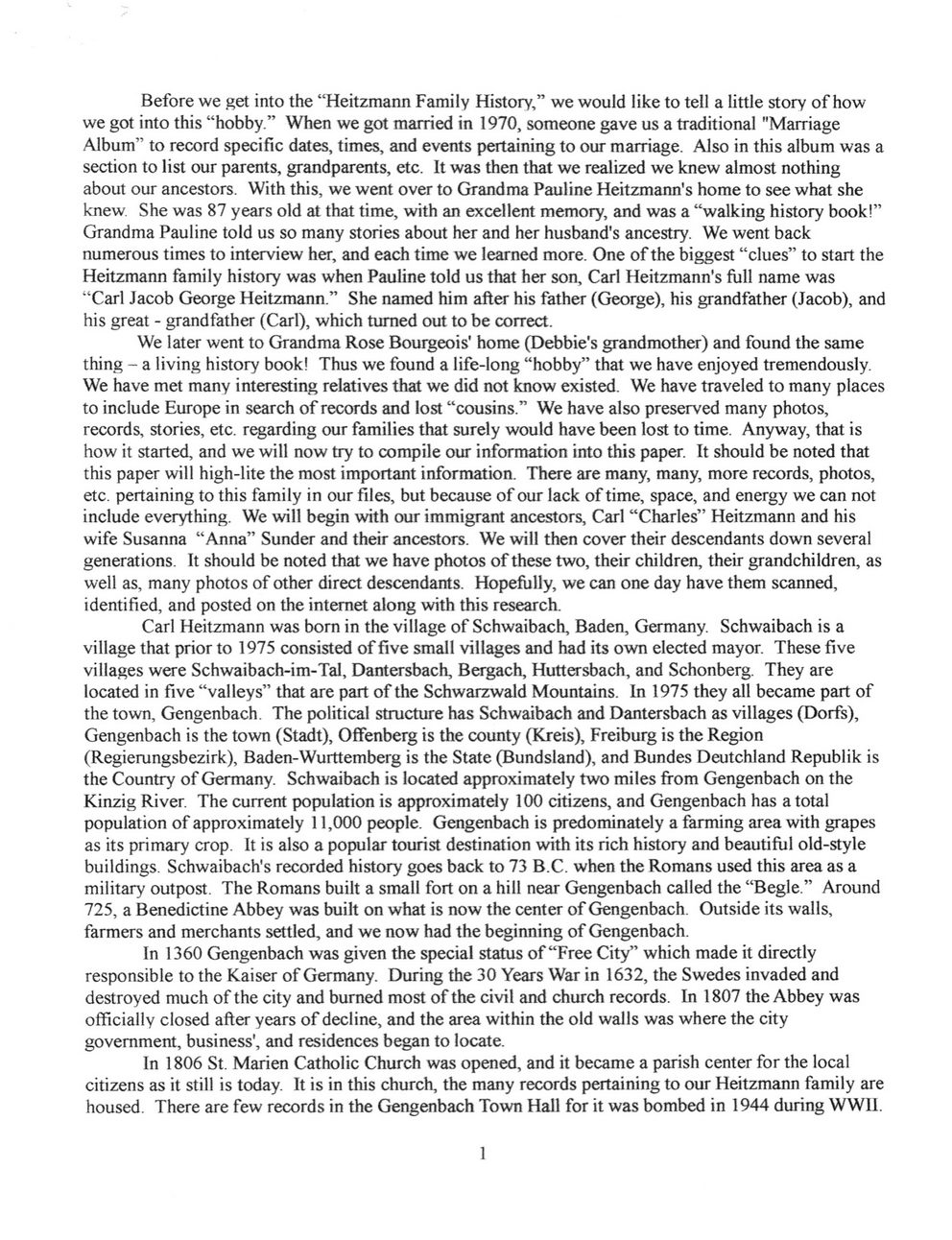This text was obtained via automated optical character recognition.
It has not been edited and may therefore contain several errors.
Before we get into the ?Heitzmann Family History,? we would like to tell a little story of how we got into this ?hobby.? When we got married in 1970, someone gave us a traditional "Marriage Album? to record specific dates, times, and events pertaining to our marriage. Also in this album was a section to list our parents, grandparents, etc. It was then that we realized we knew almost nothing about our ancestors. With this, we went over to Grandma Pauline Heitzmann's home to see what she knew She was 87 years old at that time, with an excellent memory, and was a ?walking history book!? Grandma Pauline told us so many stories about her and her husband's ancestry. We went back numerous times to interview her, and each time we learned more. One of the biggest ?clues? to start the Heitzmann family history was when Pauline told us that her son, Carl Heitzmann's full name was ?Carl Jacob George Heitzmann.? She named him after his father (George), his grandfather (Jacob), and his great - grandfather (Carl), which turned out to be correct. We later went to Grandma Rose Bourgeois' home (Debbie's grandmother) and found the same thing - a living history book! Thus we found a life-long ?hobby? that we have enjoyed tremendously. We have met many interesting relatives that we did not know existed. We have traveled to many places to include Europe in search of records and lost ?cousins.? We have also preserved many photos, records, stories, etc. regarding our families that surely would have been lost to time. Anyway, that is how it started, and we will now try to compile our information into this paper. It should be noted that this paper will high-lite the most important information. There are many, many, more records, photos, etc. pertaining to this family in our files, but because of our lack of time, space, and energy we can not include everything. We will begin with our immigrant ancestors, Carl ?Charles? Heitzmann and his wife Susanna ?Anna? Sunder and their ancestors. We will then cover their descendants down several generations. It should be noted that we have photos of these two, their children, their grandchildren, as well as, many photos of other direct descendants. Hopefully, we can one day have them scanned, identified, and posted on the internet along with this research. Carl Heitzmann was born in the village of Schwaibach, Baden, Germany. Schwaibach is a village that prior to 1975 consisted of five small villages and had its own elected mayor. These five villages were Schwaibach-im-Tal, Dantersbach, Bergach, Huttersbach, and Schonberg. They are located in five ?valleys? that are part of the Schwarzwald Mountains. In 1975 they all became part of the town, Gengenbach. The political structure has Schwaibach and Dantersbach as villages (Dorfs), Gengenbach is the town (Stadt), Offenberg is the county (Kreis), Freiburg is the Region (Regierungsbezirk), Baden-Wurttemberg is the State (Bundsland), and Bundes Deutchland Republik is the Country of Germany. Schwaibach is located approximately two miles from Gengenbach on the Kinzig River. The current population is approximately 100 citizens, and Gengenbach has a total population of approximately 11,000 people. Gengenbach is predominately a farming area with grapes as its primary crop. It is also a popular tourist destination with its rich history and beautiful old-style buildings. Schwaibach's recorded history goes back to 73 B.C. when the Romans used this area as a military outpost. The Romans built a small fort on a hill near Gengenbach called the ?Begle.? Around 725, a Benedictine Abbey was built on what is now the center of Gengenbach. Outside its walls, farmers and merchants settled, and we now had the beginning of Gengenbach. In 1360 Gengenbach was given the special status of ?Free City? which made it directly responsible to the Kaiser of Germany. During the 30 Years War in 1632, the Swedes invaded and destroyed much of the city and burned most of the civil and church records. In 1807 the Abbey was officially closed after years of decline, and the area within the old walls was where the city government, business', and residences began to locate. In 1806 St. Marien Catholic Church was opened, and it became a parish center for the local citizens as it still is today. It is in this church, the many records pertaining to our Heitzmann family are housed. There are few records in the Gengenbach Town Hall for it was bombed in 1944 during WW11. 1

Heitzmann Carl-Heitzmann-Ancestors-and-Descendants-02